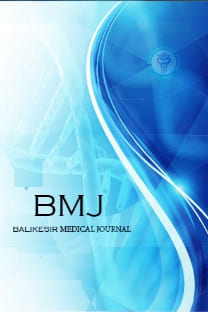Üreterde Cut-off İşareti
Obstrüktif üropati, böbrek taşları, vezikoüreteral reflü, posterior üretral kapak ve ürotelyal tümörler gibi yaygın nedenlere bağlı olarak ortaya çıkar. Ayrıca solid tümörler, retroperitoneal fibrozis, primer lenfomalar (Non-Hodgkin lenfomalar vb.) gibi nadir nedenler de vardır. Bel ağrısı olan 20 yaşındaki erkek hastaya sırt ağrısı ayırıcı tanısı için kemik taraması yapıldı. Kısa segment üreter stazının eşlik ettiği tek taraflı renal staz dışında kemik sintigrafisi bulguları normaldi. Üreteral aktivitenin ani sonlanması, yani “cutoff işareti” nedeniyle, üreter stazının ayırıcı tanısı için takip eden bir SPECT/BT görüntülemeye odaklanıldı. Tanısal olmayan BT kesitlerinde üretere bası yapan bir para-aortik yumuşak doku kitlesi saptandı. Bu vaka, ince sintigrafik bulgularda SPECT/BT görüntülemenin katma değerinin altını çizmektedir. Üreterde stazın aniden sonlanması, daha önce üriner sistem patolojisi öyküsü olmayan olgularda SPECT/BT uygulamasını gerektirebilir. SPECT/CT etiyolojinin aydınlatılmasında ek faydalar sağlayabilir.
Anahtar Kelimeler:
Cut-off bulgusu, SPECT/BT, Renal staz
Cut-off Sign in Ureter
Obstructive uropathy occurs due to common causes such as kidney stones, vesicoureteral reflux, posterior urethral valve and urothelial tumors. In addition, there are rare causes such as solid tumors, retroperitoneal fibrosis, primary lymphomas (Non-Hodgkin lymphomas etc.). A 20-year old male with lower back pain underwent a bone scan for differential diagnosis of back pain. The bone scan findings were normal, except for the presence of unilateral renal stasis accompanied by a short segment ureteral stasis. Due to the abrupt termination of the ureteral activity, namely the “cutoff sign”, a subsequent SPECT/CT imaging was focused for differential diagnosis of ureteral stasis. Non-diagnostic CT sections revealed a para-aortic soft tissue mass compressing the ureter. This case underlines the added value of SPECT/CT imaging in subtle scintigraphic findings. The abrupt termination of stasis in the ureter may warrant the application of SPECT/CT in cases with no previous history of urinary tract pathology. SPECT / CT may provide additional benefits of clarifying the etiology.
Keywords:
Cutoff sign, SPECT/CT, Renal stasis in bone scan,
___
- Khan MA, Hellawell GO, Nargund VH, Ureteric obstruction due to B-cell lymphoma. International Urology and Nephrology. 2009. 29:541–542. https://doi.org/10.1007/BF02552198
- Naeije G, Meert AP, Deneft F, et al. B-cell lymphoma presenting with renal failure associated to spontaneous tumor lysis syndrome and urinary tract obstruction. J BUON, 2005, 10:397–400
- Mourmouris PI, Chiras T, Papatsoris AG, Obstructive Uropathy: From Etiopathology to Therapy. World Journal of Nephrology and Urology, 2014, 3:1–6
- Wong L-M, Cleeve LK, Milner AD, Pitman AG, Malignant ureteral obstruction: outcomes after intervention. Have things changed? J Urol, 2007, 178:178–183; discussion 183. https://doi.org/10.1016/j.juro.2007.03.026
- Wilson JR, Urwin GH, Stower MJ, The role of percutaneous nephrostomy in malignant ureteric obstruction. Ann R Coll Surg Engl, 2005, 87:21–24. https://doi.org/10.1308/1478708051432
- Chen P-Y, Colon Cutoff Sign. N Engl J Med, 2018, 378:1621. https://doi.org/10.1056/NEJMicm1714270
- Stark D, Imaging Strategies in Oncology.1993, Wiley
- Alkhawaldeh K, Ghuweri AA, Kawar J, Jaafreh A. Back Pain in Children and Diagnostic Value of 99mTc MDP Bone Scintigraphy. Acta Inform Med,2014, 22:297–301. https://doi.org/10.5455/aim.2014.22.297-301
- Yayın Aralığı: Yıllık
- Başlangıç: 2017
- Yayıncı: Balıkesir Üniversitesi
